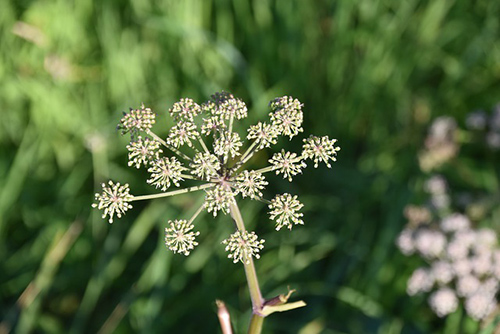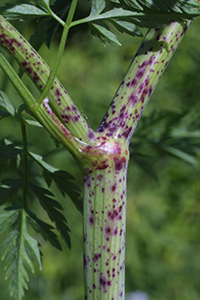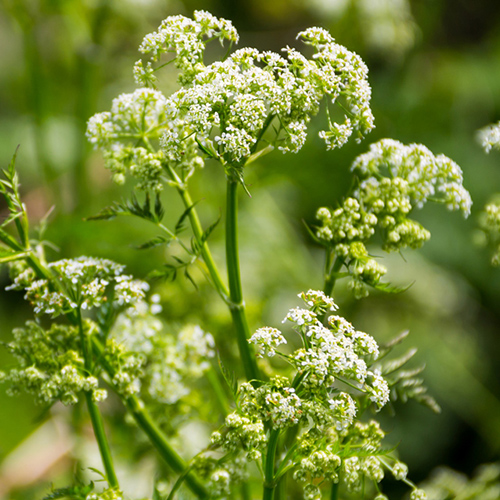Contents
Poison hemlock is quite widespread, and it is worth knowing how to distinguish it from other plants belonging to the same botanical family, Umbelliferae, to which it is similar: European angelica, parsley, celery, and even wild cherry.

Poison Hemlock Scientific Facts
- Scientific synonyms: Cicuta Officinalis Crantz. Cicuta major Lam.
- Other names: Poison parsley, cicuta, hemlock, poison root, poison snakeweed, spotted hemlock, spotted parsley, winter fern, water parsley.
- French: Cigue, grande cigue.
- Spanish: Cicuta, perejil lobuno.
- Environment: It grows wild throughout Europe and America, usually in cool and wet places, riverbanks, and roadsides.
- Description: It is an herbaceous plant that grows from 30 to 150 cm high. It belongs to the Umbelliferae family. Its stem is hollow and finely stretch-marked.
- Parts of the plant used medicinally: Fruits.
Healing Properties and Uses

All parts of poison hemlock, especially its fruits, contain diverse alkaloids (coniine, coniceine, and pseudoconhydrine), an essential oil, flavonoid, and coumarinic glycosides. Coniine is the most crucial active component of poison hemlock, present in a proportion of two percent in its fruit and 0.5 percent in its leaves. Coniine is absorbed both orally and through the skin, which penetrates pretty quickly.
Alkaloids are vegetal substances with an alkaline reaction. They have complex molecules formed by carbon, hydrogen, oxygen, and nitrogen. Their pharmacological effects are pretty strong; thus, they may produce toxic effects in small doses. In therapeutic doses, coniine and the other alkaloids of poison hemlock have a strong sedative, anesthetic, and local analgesic effect. Hemlock has been used successfully to ease the following:
- Incurable pains such as those produced by cancer.
- Persistent pain, such as that produced by neuralgia.
At present, though we can use other robust and secure analgesic substances, hemlock may still be used; however, it must always be under medical supervision and with strict observance of doses to avoid toxic effects.
How to Identify Poison Hemlock

The appearance of the poisonous hemlock plant is similar to that of other plants of its botanical family, such as celery or parsley. The following botanical details will help identify it:
- The hemlock stem differs from the stem of other Umbelliferae plants in that it possesses some reddish or purple stains on its lower part.
- The leaves are big, bright, and finely divided.
- The flowers are white, grouped in unequal umbrellas with 10 to 20 radii each.
- Its fruit is oval, about 3 mm in size, ochre-greenish in color, and crossed by foldings.
- The whole plant exudes a urine-like aroma, which is quite unpleasant.
Hemlock Poisoning

Coniine is similar in its chemical structure and effect to another alkaloid found in tobacco plants: nicotine. Both alkaloids act on the autonomic nervous system, exciting and depressing it. From half to two hours after intake of a toxic dose of coniine, there will be a burning sensation in the mouth, swallowing difficulties, nausea, pupil dilation, and weakness in the legs. If the dose is higher, it will produce muscular paralysis (like that produced by curare) and death due to respiratory failure and asphyxia. Notwithstanding, the victim is conscious, and mental control is maintained until the final moment. This explains why the Greeks chose this poison to kill prisoners sentenced to capital punishment.
Treatment of the intoxication. When there is a suspicion that someone has taken poison hemlock, vomiting must be induced, and, if possible, an immediate gastric lavage must be carried out. Give purgatives and charcoal and mouth-to-mouth resuscitation if the poisoned person has difficulty breathing. The victim must quickly be taken to a hospital.

Water Hemlock
Minor or water hemlock, also called spotted cowbane and European water hemlock, grows in wet places, like poison hemlock, though it is less frequently found than the latter. The appearance of water hemlock is similar to that of poison hemlock. Violent convulsions and, ultimately, respiratory failure define its toxic effects. Follow the same treatment as that for hemlock poisoning.
How to use Poison Hemlock
- Powder. The dried fruits of this plant are crushed into a powder that is dissolved in water. The maximum tolerated dose is one gram of fruit daily, distributed into four daily intakes of 0.25 g each.
- Lotions. It is prepared with one gram of crushed fruits for every nine grams of oily dissolvent. It is used as a local anesthetic in cases of neuralgias and intense pain. Always bear in mind that coniine is absorbed through the skin.
DISCLAIMER: All content on this website is presented solely for educational and informational objectives. Do not rely on the information provided as a replacement for advice, diagnosis, or treatment from a qualified medical expert. If you are pregnant, nursing, or have any preexisting medical concerns, talk to your doctor before using any herbal or natural medicines.
REFERENCES
- George D. Pamplona-Roger, M.D. “Encyclopedia of Medicinal Plants.” George D. Pamplona-Roger, M.D. Encyclopedia of Medicinal Plants. Ed. Francesc X. Gelabert. Vols. 1 San Fernando de Henares: Editorial Safeliz, 2000. 155, 156. Print.
- Cleaveland Clinic: https://my.clevelandclinic.org/health/diseases/24122-poison-hemlock
- WebMD: https://www.webmd.com/first-aid/poison-hemlock-poisoning
- West Virginia University Extension Service: https://extension.wvu.edu/lawn-gardening-pests/weeds/poison-hemlock
- Poison Control Center: https://www.poison.org/
